
(a)
Interpretation:
The structure of quinine in
Concept introduction:
Aliphatic
Answer to Problem 26.33AP
The structure of quinine in
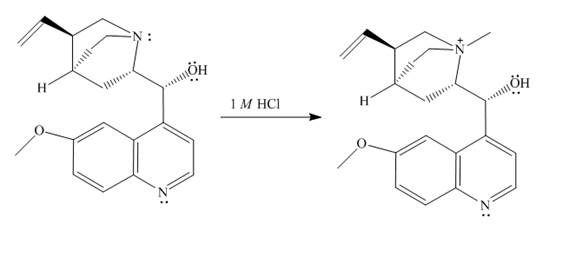
Explanation of Solution
When quinine reacts with
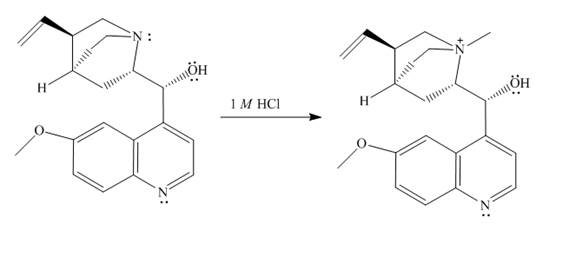
Figure 1
The structure of quinine in
(b)
Interpretation:
The structure of nicotine in
Concept introduction:
Aliphatic amines are more basic than aromatic amines. In aliphatic amines, the nitrogen atom is attached to a methyl group which is electron donating group; therefore, it increases the electron density on nitrogen by
Answer to Problem 26.33AP
The structure of nicotine in
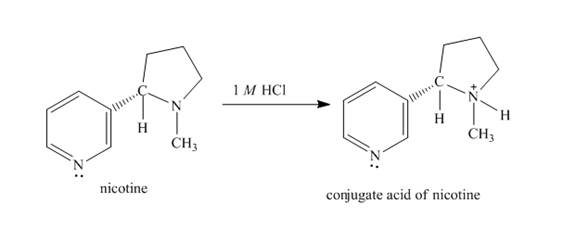
Explanation of Solution
When nicotine reacts with

Figure 2
The structure of nicotine in
(c)
Interpretation:
The structure of tryptamine in
Concept introduction:
Aliphatic amines are more basic than aromatic amines. In aliphatic amines, the nitrogen atom is attached to a methyl group which is electron donating group; therefore, it increases the electron density on nitrogen by
Answer to Problem 26.33AP
The structure of tryptamine in
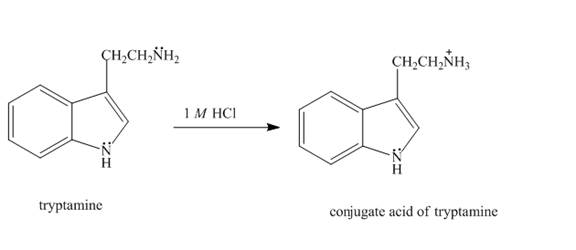
Explanation of Solution
The aliphatic amine present on the side chain of tryptamine gets protonated in

Figure 3
The structure of tryptamine in
(d)
Interpretation:
The structure of
Concept introduction:
Aliphatic amines are more basic than aromatic amines. In aliphatic amines, the nitrogen atom is attached to a methyl group which is electron donating group; therefore, it increases the electron density on nitrogen by
Answer to Problem 26.33AP
The structure of
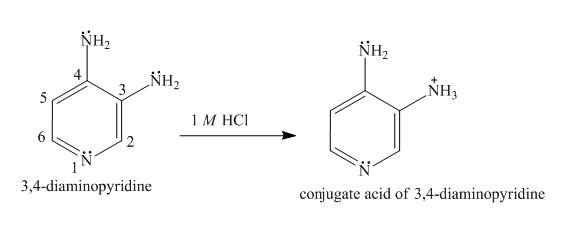
Explanation of Solution
In the structure of

Figure 4
The structure of
(e)
Interpretation:
The structure of
Concept introduction:
Aliphatic amines are more basic than aromatic amines. In aliphatic amines, the nitrogen atom is attached to a methyl group which is electron donating group; therefore, it increases the electron density on nitrogen by
Answer to Problem 26.33AP
The structure of
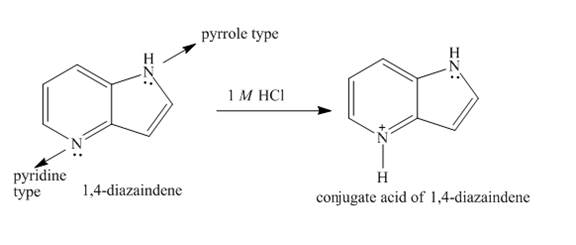
Explanation of Solution
In

Figure 5
The structure of
(f)
Interpretation:
The structure of
Concept introduction:
Aliphatic amines are more basic than aromatic amines. In aliphatic amines, the nitrogen atom is attached to a methyl group which is electron donating group; therefore, it increases the electron density on nitrogen by
Answer to Problem 26.33AP
The structure of
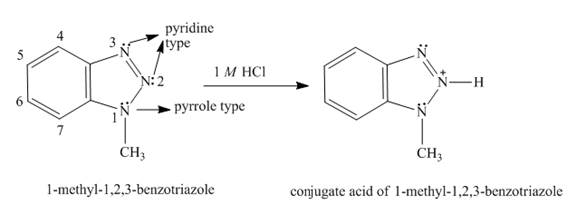
Explanation of Solution
In
The formation of conjugated acid of

Figure 6
The structure of
(g)
Interpretation:
The structure of imitanib in
Concept introduction:
Aliphatic amines are more basic than aromatic amines. In aliphatic amines, the nitrogen atom is attached to a methyl group which is electron donating group; therefore, it increases the electron density on nitrogen by
Answer to Problem 26.33AP
The structure of imitanib in
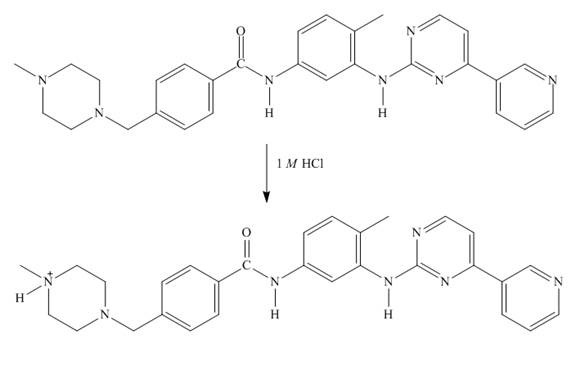
Explanation of Solution
In imitanib, the aliphatic amine will be protonated than aromatic amine since the basicity of aliphatic amines is more. The aliphatic amine present adjacent to the methyl group will be protonated as it is electron rich due to the
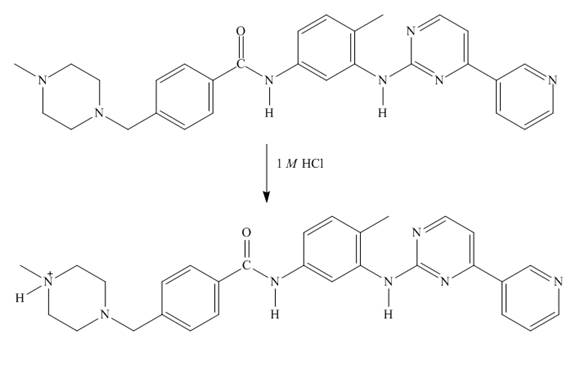
Figure 7
The structure of imitanib in
Want to see more full solutions like this?
Chapter 26 Solutions
EBK ORGANIC CHEMISTRY
- Show how to convert ethyl benzene to (a) 2,5-dichlorobenzoic acid and (b) 2,4-dichlorobenzoic acid.arrow_forwardHelp me solve this problem. Thank you in advance.arrow_forward22.7 Predict the monoalkylated products of the following reactions with benzene. (a) AlCl3 Ya (b) AlCl3 (c) H3PO4 (d) 22.8 Think-Pair-Share AICI3 The reaction below is a common electrophilic aromatic substitution. SO3 H₂SO4 SO₂H (a) Draw the reaction mechanism for this reaction using HSO,+ as the electrophile. (b) Sketch the reaction coordinate diagram, where the product is lower in energy than the starting reactant. (c) Which step in the reaction mechanism is highest in energy? Explain. (d) Which of the following reaction conditions could be used in an electrophilic aro- matic substitution with benzene to provide substituted phenyl derivatives? (i) AICI3 HNO3 H₂SO4 K2Cr2O7 (iii) H₂SO4 (iv) H₂PO₁arrow_forward
- Is an acid-base reaction the only type of reaction that would cause leavening products to rise?arrow_forwardHelp me understand this! Thank you in advance.arrow_forward22.22 For each compound, indicate which group on the ring is more strongly activating and then draw a structural formula of the major product formed by nitration of the compound. Br CHO (a) CH3 (b) (c) CHO CH3 SO₂H (d) ☑ OCHS NO₂ (e) (f) CO₂H NHCOCH3 NHCOCH, (h) CHS 22.23 The following molecules each contain two aromatic rings. (b) 000-100- H3C (a) (c) Which ring in each undergoes electrophilic aromatic substitution more readily? Draw the major product formed on nitration.arrow_forward
- V Consider this step in a radical reaction: Br: ? What type of step is this? Check all that apply. Draw the products of the step on the right-hand side of the drawing area below. If more than one set of products is possible, draw any set. Also, draw the mechanism arrows on the left-hand side of the drawing area to show how this happens. ⚫ionization termination initialization neutralization none of the abc Explanation Check 80 Ο F3 F1 F2 2 F4 01 % do5 $ 94 #3 X 5 C MacBook Air 25 F5 F6 66 ©2025 ˇ F7 29 & 7 8arrow_forwardShow how to convert ethyl benzene to (a) 2,5-dichlorobenzoic acid and (b) 2,4-dichlorobenzoic acid.arrow_forwardno aiarrow_forward
- Polymers may be composed of thousands of monomers. Draw three repeat units (trimer) of the polymer formed in this reaction. Assume there are hydrogen atoms there are hydrogen atoms on the two ends of the trimer. Ignore inorganic byproducts.arrow_forwardDraw a tetramer if this alternating copolymer pleasearrow_forwardDraw the monomers required to synthesize this condensation polymer.arrow_forward
 ChemistryChemistryISBN:9781305957404Author:Steven S. Zumdahl, Susan A. Zumdahl, Donald J. DeCostePublisher:Cengage Learning
ChemistryChemistryISBN:9781305957404Author:Steven S. Zumdahl, Susan A. Zumdahl, Donald J. DeCostePublisher:Cengage Learning ChemistryChemistryISBN:9781259911156Author:Raymond Chang Dr., Jason Overby ProfessorPublisher:McGraw-Hill Education
ChemistryChemistryISBN:9781259911156Author:Raymond Chang Dr., Jason Overby ProfessorPublisher:McGraw-Hill Education Principles of Instrumental AnalysisChemistryISBN:9781305577213Author:Douglas A. Skoog, F. James Holler, Stanley R. CrouchPublisher:Cengage Learning
Principles of Instrumental AnalysisChemistryISBN:9781305577213Author:Douglas A. Skoog, F. James Holler, Stanley R. CrouchPublisher:Cengage Learning Organic ChemistryChemistryISBN:9780078021558Author:Janice Gorzynski Smith Dr.Publisher:McGraw-Hill Education
Organic ChemistryChemistryISBN:9780078021558Author:Janice Gorzynski Smith Dr.Publisher:McGraw-Hill Education Chemistry: Principles and ReactionsChemistryISBN:9781305079373Author:William L. Masterton, Cecile N. HurleyPublisher:Cengage Learning
Chemistry: Principles and ReactionsChemistryISBN:9781305079373Author:William L. Masterton, Cecile N. HurleyPublisher:Cengage Learning Elementary Principles of Chemical Processes, Bind...ChemistryISBN:9781118431221Author:Richard M. Felder, Ronald W. Rousseau, Lisa G. BullardPublisher:WILEY
Elementary Principles of Chemical Processes, Bind...ChemistryISBN:9781118431221Author:Richard M. Felder, Ronald W. Rousseau, Lisa G. BullardPublisher:WILEY





